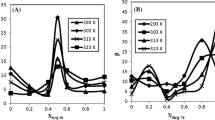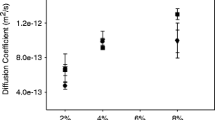Abstract
Aqueous two-phase system (ATPS), also called “water-in-water” emulsion, is a multi-component system (aqueous droplets dispersed in a continuous aqueous phase), formed after gently mixing two aqueous solutions of immiscible polymers. It allows the formation of different compartments without adding any organic solvent, according to a green process. Nevertheless, the kinetic stability of ATPS is generally difficult to control. Phase diagrams, which express the concentration of a polymer as a function of that of the other in solution, are used to characterise ATPS and to determine conditions for preparing emulsions from selected polymers. In this study, dextran and polyethylene oxide aqueous mixtures with different processing parameters are investigated. Phase diagrams are generated through two automatic methods (Turbiscan and LUMiSizer® technologies) and a manual one. With the diagrams obtained, it is concluded that the purity of polyethylene oxide affects the ATPS, whereas the use of polymers in powder or in solution form has no effect. In view of this result, it is allowed to prepare ATPS formulation by a simple one-step process from polymers in powder form.
Graphical abstract





Similar content being viewed by others
Data availability
Supporting information is available.
Abbreviations
- ATPS:
-
aqueous two-phase system
- Dex:
-
dextran
- PEO:
-
polyethylene oxide
- Wt%:
-
mass concentration as a percentage
References
Sagis LMC (2009) Dynamics of encapsulation and controlled release systems based on water-in-water emulsions: liposomes and polymersomes. Phys A Stat Mech Appl 388:2579–2587. https://doi.org/10.1016/j.physa.2009.03.024
Ruiz-Ruiz F, Benavides J, Aguilar O, Rito-Palomares M (2012) Aqueous two-phase affinity partitioning systems: current applications and trends. J Chromatogr A 1244:1–13. https://doi.org/10.1016/j.chroma.2012.04.077
Fan W, Glatz CE (1999) Charged protein partitioning in aqueous polyethylene glycol-dextran two-phase systems: salt effects. Sep Sci Technol 34:423–438. https://doi.org/10.1081/SS-100100659
Fan W, Bakir U, Glatz CE (1998) Contribution of protein charge to partitioning in aqueous two-phase systems. Biotechnol Bioeng 59:461–470. https://doi.org/10.1002/(SICI)1097-0290(19980820)59:4<461::AID-BIT9>3.0.CO;2-E
Jiang J, Prausnitz JM (2000) Molecular thermodynamics for partitioning of native and denatured proteins in aqueous two-phase systems. J Phys Chem B 104:7197–7205. https://doi.org/10.1021/jp994371h
Johansson H-O, Persson J, Tjerneld F (1999) Thermoseparating water/polymer system: a novel one-polymer aqueous two-phase system for protein purification. Biotechnol Bioeng 66:247–257. https://doi.org/10.1002/(SICI)1097-0290(1999)66:4<247::AID-BIT6>3.0.CO;2-5
Iqbal M, Tao Y, Xie S, Zhu Y, Chen D, Wang X, Huang L, Peng D, Sattar A, Shabbir MAB, Hussain HI, Ahmed S, Yuan Z (2016) Aqueous two-phase system (ATPS): an overview and advances in its applications. Biol Proced Online 18:18. https://doi.org/10.1186/s12575-016-0048-8
Atefi E, Joshi R, Tavana H (2017) Effect of molecular weight of phase polymers on partition of cells in aqueous two-phase systems. MRS Adv 2:2415–2426. https://doi.org/10.1557/adv.2017.425
Sumida E, Iwasaki Y, Akiyoshi K, Kasugai S (2006) Platelet separation from whole blood in an aqueous two-phase system with water-soluble polymers. J Pharmacol Sci 101:91–97. https://doi.org/10.1254/jphs.FP0060062
Atefi E, Lemmo S, Fyffe D, Luker GD, Tavana H (2014) High throughput, polymeric aqueous two-phase printing of tumor spheroids. Adv Funct Mater 24:6509–6515. https://doi.org/10.1002/adfm.201401302
Zaslavsky A, Madeira P, Breydo L, Uversky VN, Chait A, Zaslavsky B (2013) High throughput characterization of structural differences between closely related proteins in solution. Biochim Biophys Acta Protein Proteomics 1834:583–592. https://doi.org/10.1016/j.bbapap.2012.11.004
Buzza DMA, Fletcher PDI, Georgiou TK, Ghasdian N (2013) Water-in-water emulsions based on incompatible polymers and stabilized by triblock copolymers-templated polymersomes. Langmuir 29:14804–14814. https://doi.org/10.1021/la403356j
Stenekes RJH, Franssen O, van Bommel EMG, Crommelin DJA, Hennink WE (1999) The use of aqueous PEG/dextran phase separation for the preparation of dextran microspheres. Int J Pharm 183:29–32. https://doi.org/10.1016/S0378-5173(99)00038-1
Sagis LMC (2008) Dynamics of controlled release systems based on water-in-water emulsions: a general theory. J Control Release 131:5–13. https://doi.org/10.1016/j.jconrel.2008.07.010
Ghosh S, Vijayalakshmi R, Swaminathan T (2004) Evaluation of an alternative source of dextran as a phase forming polymer for aqueous two-phase extractive system. Biochem Eng J 21:241–252. https://doi.org/10.1016/j.bej.2004.07.005
Edelman MW, Van Der Linden E, Tromp RH (2003) Phase separation of aqueous mixtures of poly(ethylene oxide) and dextran. Macromolecules 36:7783–7790. https://doi.org/10.1021/ma0341622
Leng D, Thanki K, Fattal E, Foged C, Yang M (2018) Engineering of budesonide-loaded lipid-polymer hybrid nanoparticles using a quality-by-design approach. Int J Pharm 548:740–746. https://doi.org/10.1016/j.ijpharm.2017.08.094
Scholten E, Sagis LMC, van der Linden E (2006) Effect of bending rigidity and interfacial permeability on the dynamical behavior of water-in-water emulsions. J Phys Chem B 110:3250–3256. https://doi.org/10.1021/jp056528d
Balakrishnan G, Nicolai T, Benyahia L, Durand D (2012) Particles trapped at the droplet interface in water-in-water emulsions. Langmuir 28:5921–5926. https://doi.org/10.1021/la204825f
Nguyen BT, Nicolai T, Benyahia L (2013) Stabilization of water-in-water emulsions by addition of protein particles. Langmuir 29:10658–10664. https://doi.org/10.1021/la402131e
Atefi E, Mann JA, Tavana H (2014) Ultralow interfacial tensions of aqueous two-phase systems measured using drop shape. Langmuir 30:9691–9699. https://doi.org/10.1021/la500930x
Sagis LMC (2008) Dynamics of encapsulation and controlled release systems based on water-in-water emulsions: negligible surface rheology. J Phys Chem B 112:13503–13508. https://doi.org/10.1021/jp806014b
Kaul A (2000) The phase diagram. Methods Biotechnol 11:11–21. https://doi.org/10.1385/1-59259-028-4:11
Forciniti D, Hall CK, Kula M-R (1991) Influence of polymer molecular weight and temperature on phase composition in aqueous two-phase systems. Fluid Phase Equilib 61:243–262. https://doi.org/10.1016/0378-3812(91)80002-D
Shin H, Han C, Labuz JM, Kim J, Kim J, Cho S, Gho YS, Takayama S, Park J (2015) High-yield isolation of extracellular vesicles using aqueous two-phase system. Sci Rep 5:13103. https://doi.org/10.1038/srep13103
Ooi CW, Hii SL, Kamal SMM, Ariff A, Ling TC (2011) Extractive fermentation using aqueous two-phase systems for integrated production and purification of extracellular lipase derived from Burkholderia pseudomallei. Process Biochem 46:68–73. https://doi.org/10.1016/j.procbio.2010.07.014
Chavez-Santoscoy A, Benavides J, Vermaas W, Rito-Palomares M (2010) Application of aqueous two-phase systems for the potential extractive fermentation of cyanobacterial products. Chem Eng Technol 33:177–182. https://doi.org/10.1002/ceat.200900286
Amrhein S, Schwab ML, Hoffmann M, Hubbuch J (2014) Characterization of aqueous two phase systems by combining lab-on-a-chip technology with robotic liquid handling stations. J Chromatogr A 1367:68–77. https://doi.org/10.1016/j.chroma.2014.09.042
Ferreira LA, Uversky VN, Zaslavsky BY (2018) Modified binodal model describes phase separation in aqueous two-phase systems in terms of the effects of phase-forming components on the solvent features of water. J Chromatogr A 1567:226–232. https://doi.org/10.1016/j.chroma.2018.07.005
Rao W, Wang Y, Han J, Wang L, Chen T, Liu Y, Ni L (2015) Cloud point and liquid-liquid equilibrium behavior of thermosensitive polymer L61 and salt aqueous two-phase system. J Phys Chem B 119:8201–8208. https://doi.org/10.1021/acs.jpcb.5b03201
Fele L, Fermeglia M (1996) Partition coefficients of proteins in poly(ethylene glycol) + dextran + water at 298 K. J Chem Eng Data 41:331–334. https://doi.org/10.1021/je9502298
Hatti-Kaul R (2001) Aqueous two-phase systems: a general overview. Mol Biotechnol 19:269–278. https://doi.org/10.1385/MB:19:3:269
Asenjo JA, Andrews BA (2012) Aqueous two-phase systems for protein separation: phase separation and applications. J Chromatogr A 1238:1–10. https://doi.org/10.1016/j.chroma.2012.03.049
Torres-Acosta MA, Mayolo-Deloisa K, González-Valdez J, Rito-Palomares M (2018) Aqueous two-phase systems at large scale: challenges and opportunities. Biotechnol J 1800117:1800117. https://doi.org/10.1002/biot.201800117
Code availability
Not applicable.
Author information
Authors and Affiliations
Corresponding author
Ethics declarations
Conflicts of interest
The authors declare that they have no conflict of interest.
Additional information
Publisher’s note
Springer Nature remains neutral with regard to jurisdictional claims in published maps and institutional affiliations.
Electronic supplementary material
ESM 1
(PDF 556 kb)
Rights and permissions
About this article
Cite this article
Dumas, F., Roger, E., Rodriguez, J. et al. Aqueous Two-Phase Systems: simple one-step process formulation and phase diagram for characterisation. Colloid Polym Sci 298, 1629–1636 (2020). https://doi.org/10.1007/s00396-020-04748-8
Received:
Revised:
Accepted:
Published:
Issue Date:
DOI: https://doi.org/10.1007/s00396-020-04748-8




